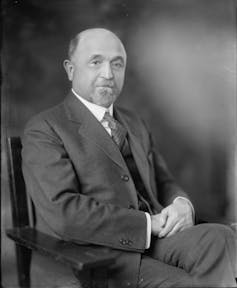During his three presidential campaigns, Donald Trump promised to run the federal government as if it were a business. True for his speech, after recovering his assignment, Trump placed Elon Musk’s technology billionaire at the head of a new group in the executive branch called the Government Efficiency Department.
Doge, as the Musk’s initiative is known, has so far resigned, rested or resigned from tens of thousands of federal workers and says it has discovered large amounts of digestive or spent taxes. But even his controversial claim to save $ 65 billion is less than 1% of the $ 6.75 trillion that the US spent in the 2024 fiscal year, and a small portion of the country’s $ 36 -trillion cumulative debt. Because Musk’s surgery has not been officially official, indiscriminate cuts also ask constitutional disturbing questions and may be illegal.
Before going too far trying to run the government as a business, Trump and his advisers may want to consider the very different example of the country’s first chief executive while he was in office.
Andrew Harnik/Getty Images
The first businessman to become president
Like Trump, George Washington was a businessman with a large real estate wallet. Along with property in Virginia and six other states, he had extensive claims for indigenous land in the Ohio River valley.
Partly because of those distant investments, the first president supported large transport projects, received an active interest in the invention of steamboat, and founded the Patowmack company, a precursor to the builders of Chesapeake and Ohio Canal.
Above all, Washington was a farmer. In his Mount Vernon’s wealth, in northern Virginia, he grew tobacco and wheat and led a mill. After his second term as president, he built a lucrative distiller. At the time of his death, he owned nearly 8,000 hectares of production farm and forests, almost four times his original heritage.
Much of Washington’s wealth was based on slaves’ work. In his will, he released 123 of the 300 African -enslaved African who had made his successful business possible, but while he lived, he expected his workers to do as he said.
President Washington and Congress
If Washington, the businessman and the plantation owner, was accustomed to convinced, he knew that being president was another matter.
At the beginning of 1790, near the end of his first year in office, he reflected on the change in a letter to the English historian Catharine Macaulay. Macaulay had visited Mount Vernon a few years ago. She was looking forward to listening to the president’s thoughts on what, in his response, described as “the last excellent experiment for promoting human happiness by the reasonable compact”.
The new government, Washington wrote, was “a government of accommodation, as well as a government of laws”.
As the head of the executive branch, his powers were limited. In the months since the inauguration, he had learned that “he had to be done by prudence, many by reconciliation, many of the endurance. Few, who are not philosophical spectators,” he told his friend, “can realize the difficult and delicate part that a man in my situation (has) to act.”
Although Washington did not say why his situation was delicate, he did not need him. Congress, as everyone knew, was the most powerful branch of the government, not the President.
Last spring, Congress had shown how powerful it was when he argued whether the president, who needed Senate’s confirmation to appoint the presidents of the executive departments, could remove such officers without the approval of the same body. In the so -called decision of 1789, Congress determined that the President had that power, but only after Vice President John Adams broke the blocking in the upper room.
The meaning of the congress vote was clear. On issues when the Constitution is unclear, the Congress will decide which powers the president can exercise and what powers he – or, one day, cannot.
When creating a “sinking fund” in 1790 to manage national debt, Congress showed how far it could limit the presidential power.
Although the fund was part of the Treasury Department, whose secretary served to the pleasure of the President, the commission that overseen it served for fixed conditions set by Congress. The President could neither remove them nor tell them what to do.
Inefficient efficiency

Congress Library
Limiting Washington’s power over the last fund commission, Congress imposed a precedent that still holds, especially in the 1935 Supreme Court’s case by Humphrey’s executor v.
For the dissatisfaction of those, including Trump, who promotes the theory of the “Unitary Executive” novel by an almighty president, the court ruled that President Franklin D. Roosevelt could not rest a member of the Federal Commerce Commission before his term ended, even if, as Roosevelt said, the goals of his administration would “be” more effective “.
Like the businessman who currently occupies the White House, Washington did not always like to share power with the congress. Its members were stubborn and independent. They rarely did what they were told.
But he realized to work with Congress was the only way to create a federal government that was truly effective, with each branch that performed its designated powers, as the founders intended. Due to the controls and balances of the Constitution, the United States were – and are – a compromise -based government between the three branches. No one, not even the president, is excluded.
For his loan, Washington was quick to learn that lesson.